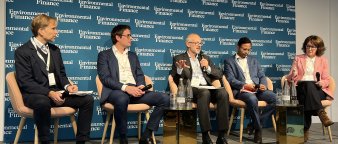You are part of the Storebrand Asset Management sustainability team, as the Head of Climate and Environment - what does a typical workday look like for you?
My workday is diverse; no two days are the same. I'm involved in a wide range of tasks, from creating policies related to climate and environment for Storebrand Asset management to conducting dialogues with companies and government bodies. A significant part of my time is devoted to collaborating with fellow investors in various initiatives like Climate Action 100+, where Storebrand holds a leading role. The global financial sector has made a commitment of achieving net-zero emissions by 2050. The most effective pathway to this goal is through collective action and collaboration.
What inspired you in the past to want to work on climate and environmental issues?
I started working on environmental issues back in 2003, and my interest in the field was sparked during my studies. Since then, the situation has become more serious. The world's countries are facing the twin crisis of climate and nature, and time is running out. At the same time, it has probably never been more incorrect to believe that it is too late to do something, and more right than ever before to work on climate and environmental issues.
A big question, but if you had to briefly describe the state of the world's climate and environment and how it has changed over the past few decades, what would you highlight?
The earth has become warmer, and the consequences of this are being felt everywhere. The UN has shown that climate change has led to more extreme weather, and in the future, we will be affected more frequently and severely by heatwaves, hurricanes, floods, and droughts. Poor harvests, bacterial epidemics, and rising sea levels can no longer be ignored, and it's the vulnerable communities that historically have contributed the least to emissions that are experiencing the worst negative consequences.
Furthermore, the UN emphasises that we are in the midst of a nature crisis, with the risk of a million species becoming extinct if we fail to save the ecosystems they inhabit. We have already reduced the world's wildlife population by 69 percent since 1970, and the decline continues at an increasingly rapid pace, leading to what is often described as "the sixth mass extinction" due to the rapid loss of valuable ecosystems.
Your job is to examine financial risks associated with natural hazards. Can you explain how these are linked and why, for example, biodiversity is crucial for potential continued production and growth worldwide?
Nature provides a wide range of ecosystem services on which the economy relies on. Examples of such services, include pollination, flood mitigation, carbon storage, and the purification of water, air, and soil. The value of these services has been estimated to $120-145 trillion annually, or in other words, over one and a half times the global gross domestic product. The World Economic Forum (WEF) estimates that half of the global gross domestic product is either highly or moderately dependent on nature and the services it provides. At the same time, many sectors continue to have negative impact on biodiversity loss. For nature to continue to provide its services to the economy, it is necessary to protect and restore nature.
The entire world's environment and the figures you've presented are enormous issues to address and solve for society, business, and individuals. How does one work as an asset manager to change and influence in this area?
When it comes to nature, it has so far been challenging for the industry to analyse and manage these risks in a systematic manner. The main reason for this is the lack of data at the company level. Therefore, it was extremely important for Storebrand to be present in Montreal during the COP 15 UN Biodiversity Conference and ensure that the new agreement has an explicit reference corporate reporting on nature.
The new agreement urges authorities to ensure that companies report on their impact on and dependence on nature, and we already see this materialise in the form of new regulations in several jurisdictions, including the EU through CSRD (Corporate Sustainability Reporting Directive). This information will allow financial institutions to compare and assess companies and manage the risks with the aim of redirecting capital away from companies that contribute to the destruction of nature.
And without data - what can you do then?
In the absence of data, we have made the best of available /existing data. We know which factors are driving the loss of nature. According to the UN, land use change is the primary cause of biodiversity loss. An example of this is when we convert forests into agricultural land. Secondly, we know which ecosystems are most valuable in terms of biodiversity or the biodiversity hotspots. One such ecosystem is the rainforest. Even though rainforests cover only 6 percent of the Earth's surface, half of the world's species live here. And that's a conservative estimate: Some estimates suggest that as much as 80 percent of all terrestrial species are found in the rainforest.
With this information as a starting point, we have dedicated considerable time to eliminate commodity driven deforestation from our investments. A combination of available company data and satellite imagery has allowed us to identify companies in our portfolios that may be linked to activities that drive deforestation. This ranges from companies producing soy in Brazil to Norwegian salmon industry using Brazilian soy in their salmon farms. We expect these companies to ensure full traceability and provide documentation demonstrating that they have not contributed to deforestation at any stage of their production chain.
The need for data in sustainability has long been discussed, emphasising that without proper reporting in place, one cannot act fully. How do you respond to this, and what is generally the most 3 challenging aspect within your field of work?
Data is a fundamental prerequisite for risk management. Without robust information, we cannot compare companies within a particular sector. However, the lack of data can also be used as an excuse for not taking action.
Sometimes, what is needed isn't more data or perfect data, but rather the right type of information to make the crucial decisions.
And what can and should an institutional investor consider regarding their investments related to nature?
Firstly, it is important to understand exposure and identify risks and opportunities. There has been tremendous progress in this area in recent years, both in terms of developing frameworks such as TNFD (Taskforce on Nature-related Disclosures) and in terms of data availability. The so-called LEAP approach is of central to TNFD framework and serves as guidance for how businesses should systematically work to identify, evaluate, and report nature-related risks.
The acronym LEAP stands for:
- Locate: Identify/locate the interfaces between the business and nature
- Evaluate: Assess the business's dependence on and impact on nature
- Assess: Evaluation of the business's risks and opportunities
- Prepare: Preparation for managing nature-related risks and reporting
When I hear the staggering figures you mention about the changes that have occurred in climate and the environment, it feels stressful and overwhelming because these are significant global issues and enormous problems we must address as a society. But it also sounds hopeful because there are solutions. How do you find the energy to continue driving and raising awareness of these important issues?
I think it's entirely natural to feel gloomy when reading the UN's predictions about the future of the planet. At the same time, it's essential to balance pessimism with optimism. We work in a sector that is absolutely crucial for the transition, and the capital market plays a decisive role in shifting towards a greener society. I am highly motivated by working in a sector and being part of an institution that has demonstrated that we can make advancements especially when we involve the full breadth of financial institutions.
You recently spoke at “Risk & Return”, a major investor event in Stockholm. What other interesting assignments and projects do you have ahead of you, and is there any particular climate and environmental issue that is particularly relevant?
We are currently working on a document together with Finance for Biodiversity and 170 other financial institutions which will be released later in April. This document lays out policy measures and instruments that needed to align financial flows with the Kunming-Montreal Agreement. Enabling environment is absolutely crucial if the financial sector is to play its role in the transition.







